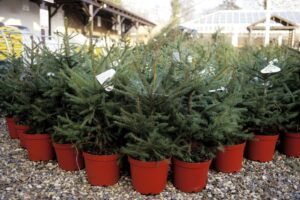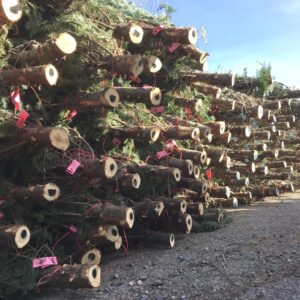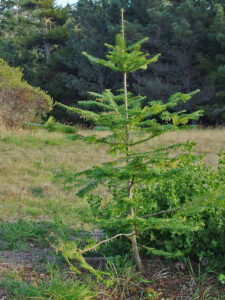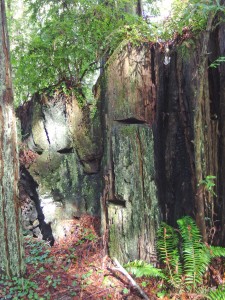Posts Tagged ‘trees’
Death of a Christmas Tree
We’d bought the young spruce in a fit of environmental consciousness when we still lived in Cupertino, CA. and it served as our Christmas tree for several years. In 1973 it survived our move to Santa Barbara, carefully bolstered in the U-Haul truck so it wouldn’t get smushed. It put up with a year or so of Santa Barbara sunshine, had even come into the house one holiday season. But that year, 1975, the temperature spiked into the 80s just after Christmas and hot sun streamed into the house. I was too busy with holiday guests and activities to think about moving the tree outside into the shade, so it stayed inside far too long. By the time we disburdened it of its decorations and lugged it back outside, the damage was already done. Months later, when I could no longer bear to look at pathetic brown needles, I removed it from its pot. The roots were tightly bound around each other.
One received wisdom is that you buy a potted tree for the holidays, then plant it in your garden. But this is not realistic if the tree’s grown size will overpower existing plantings, or if its natural habitat is elsewhere. I found a curious example of this when a few decades later we moved to Mendocino. In the patch of native forest on our property I found two trees with silvery needles. A naturalist friend identified them as some kind of spruce, definitely not native. She told me the story of how they most likely got there. The original developer had been hauled into court for illegally logging the property to create a “view development” and was ordered to replant. She speculated that he picked up a job lot of leftover Christmas trees to fulfill this requirement. Our two spruces, crowded out by redwood and Douglas fir, did not survive much longer.
So what to do about a Christmas tree? Over the years we’ve tried various approaches. We’ve gone to cut-your-own tree farms. But sawing into a young tree felt like committing murder. We’ve bought a cut tree from a lot and kept it outside in a tub of water for as long as possible. Even so, it would be shedding needles even before it came into the house. It would have been been cut weeks before, and shipped hundreds of miles from where it was grown. We’ve thinned out young firs from our own property. But they’ve been spindly little things, too likely to topple.
For the past couple of years, we’ve not bothered with a tree at all. I’ll maybe clip some low-hanging conifer branches to make a big arrangement in a bowl on the dresser or a wreath for the door. But that’s about it. I like my trees living. Like this baby Grand Fir that workers clearing a drainage channel a few weeks ago rescued from an overgrown coyote bush and saved for me.
The Standing Still Beings
With enough imagination, any group of two or three lines or dots can become a face. Sunlight filtering through the forest one afternoon this week made me see faces in an old redwood stump I passed as I strolled down the service road to our neighborhood’s pump house in Jack Peters Creek. The “eyes” and “mouth” are actually slots hacked by long ago lumberjacks to cantilever the boards on which they would have stood to saw down the giant tree.
I was drawn to these “faces” because of a recent New Yorker article, “The Intelligent Plant” by Michael Pollan. In it, Pollan notes how wary many scientists are of any hint of parallels between animal senses and plant senses, or of suggestions that plants have intelligence, which he defines as “capable of cognition, communication, information processing, computation, learning, and memory.” Pollan goes on to describe a number of plant studies that do indeed demonstrate such capabilities.
The problem is language. The words we have for intelligence in the animal world (brain, neural networks, etc.) and for the tools of sensory information (ears, eyes, nose, etc.) don’t work for beings whose mode of communication is complex biochemicals: pheromones transmitted by leaves through the air, and electrochemical signals sent by root tips through a network of mycorrhizal fungi. It’s as if we were trying to comprehend and describe the lives of beings on an alien planet.
What I took away from Pollan’s article was a renewed respect for the beauty and complexity of our natural world, and a renewed awareness of how much we humans don’t yet understand. I know the “faces” are just human-made gashes in the trees. But they serve to remind me that I, who have legs to move around, live among the standing still beings, of whose lives I am ignorant.



